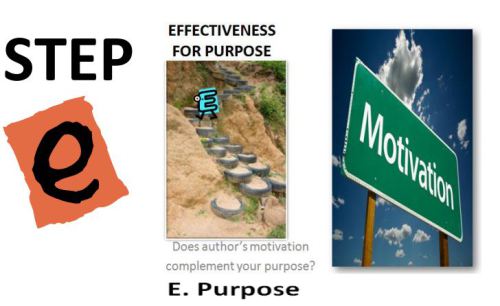Step E: Seven Steps To Website Evaluation For Students- Effectiveness For Purpose

Welcome to a this fourth in a series that is must read for any educator wanting to facilitate web page evaluation by students. It includes a new step in web evaluation information along with a poster for that step you can use in the classroom Best of all, it supports students becoming scholarly digital citizens. First, to ensure you do not miss one of these valuable posts or other resources covering PBL, Digital Curriculum, Web 2.0, STEM, 21st century learning, and technology integration please sign up for 21centuryedtech by email or RSS. As always, I invite you to follow me on twitter (@mjgormans). Please give this post a retweet and pass it on. Have a great week – Michael Gorman (21centuryedtech)
The Seven Steps to Web Site Evaluation – Step E
Welcome to the web site evaluation page evaluation series of posts. As I speak with educators across the nation I find there is a need for all teachers to emphasize proper web site evaluation by students. As part of my Digital Native/Digital Immigrant Presentation I call on Digital Immigrants (You and Me) to use their life long experience and education to show Digit ital Natives (Our students), how to make the best use of information they find on the web. In fact finding the information is a whole other topic and you can learn in some future posts
I believe that web evaluation must be a simple process that can also be applied to memory. Thus the reason for my (A-G) approach. This series is devoted to teaching these skills and I have spent hours preparing resources that you are free to use. I have divided this series using my A-G approach. Please, if you ever have the opportunity, visit me at one of my conference presentations, check out one of my webinars, or invite me to your school district to help inform your entire faculty. It really is time to help kids understand that there are no whales in Lake Michigan, the Southwest Tree Octopus is nonexistent, study of cats and bearded men did not really happen, moon creatures failed to film the lunar landing, and Columbus was not born in Australia. Please enjoy, share, and use!
E Is For Effectiveness For Purpose
Good research depends on the ability of the researcher to know exactly what the purpose of his research is. One must determine if the website being evaluated provides for the needs of that purpose. A biased site could be useful if it provides valuable arguments and defendable facts that assist the researcher in his mission. Writing a fair and balanced paper may require quotes that represent both sides of an issue. Knowing one’s purpose is possibly the most important idea to investigate before seeking information from the internet.
1. What Is The Purpose Of The Site? – Most websites exist on the internet for a specific purpose. This could be to sway opinion, propagate a movement, make money, provide educational material, disperse information, or to genuinely share with others. Regardless of the purpose for researching a topic, a good researcher must always be aware of the need to unveil the
purpose of the website being evaluated. Determining this may mean getting more information about the author/sponsor. It may also demand that the researcher dissect the domain URL seeking information regarding sponsorship, website type, and country of origin.
Detecting bias or sensing commercial activity does not automatically mean that a website is not proper for research. The important point is that the researcher becomes aware, as much as possible, of the purpose and reason for a website’s existence.
2. What Is Your Purpose? – Along with determining what may either be an obvious or hidden reason for a website’s existence, good researchers must also be aware of their own research related needs. Whether it be for personal satisfaction, or an assigned task at school or work, the goal of intended research must be clear. The vision created for research must be kept in mind and be the object of constant focus. By practicing this, a researcher will keep on a straight path toward the targeted vision of purpose. This allows the researcher to avoid the pitfall of a lack of productivity that comes from distraction by websites that could be interesting, filled with information, and enjoyable to investigate, but do not satisfy the researcher’s purpose.
Tools and ideas to transform education. Sign up below.
3. Do They Complement Each Other? – This is the all important concept that guides a researcher through the idea of “effectiveness for purpose.” Being aware of one’s research needs and weighing those needs with the perceived purpose for a webpage’s existence is a key to proper research. Even an opinionated or biased page may assist a researcher. Such a website could be valuable in the pre-search stage as the researcher is beginning to learn more about a subject. It can provide information for further verification of information, supply arguments that allow two sides of an issue to be debated, or possibly giver the researcher concepts that can be supported or rebutted. It is still important to use other reputable sites to verify facts. Understanding the power of using a website that complements research needs and gauging “Effectiveness for Purpose” will bring success to any research effort.
Download Poster Here: e1_poster_info
Enjoying the series?… Please let me know by email, response, and sign up… and please share with a Retweet!
cross-posted at 21centuryedtech.wordpress.com
Michael Gorman oversees one-to-one laptop programs and digital professional development for Southwest Allen County Schools near Fort Wayne, Indiana. He is a consultant for Discovery Education, ISTE, My Big Campus, and November Learning and is on the National Faculty for The Buck Institute for Education. His awards include district Teacher of the Year, Indiana STEM Educator of the Year and Microsoft’s 365 Global Education Hero. Read more at 21centuryedtech.wordpress.com.
